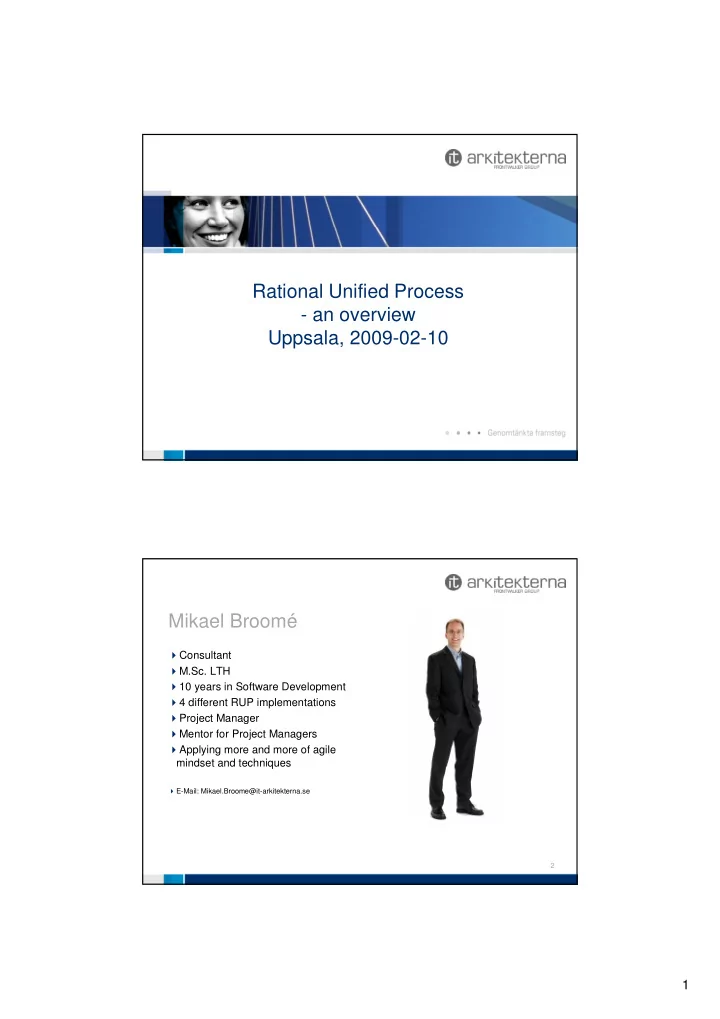

Rational Unified Process - an overview Uppsala, 2009-02-10 Mikael Broomé � Consultant � M.Sc. LTH � 10 years in Software Development � 4 different RUP implementations � Project Manager � Mentor for Project Managers � Applying more and more of agile mindset and techniques � E-Mail: Mikael.Broome@it-arkitekterna.se 2 1
Agenda � Why a process for developing software? � What is RUP? � What is the “RUP-way” of developing software? � How is RUP packaged? � Advantages by using RUP? � Challenges when using RUP? � Relation to other processes? 3 A good project � delivers the right solution: � satisified Users � satisfied Sponsor � delivers in time � delivers on budget 4 2
Challenges Common challenges in software development projects: � Capture the “right” requirements. � Requirement changes. � Different parts of the system do not fit together. � Small changes causes big problems. � Low quality and poor performance. � Major problems identified late in projects. � Lack of communication. � Difficult to estimate time and cost. � Management of environment, platforms and tools. 5 It’s all about (lack of) communication 6 3
Agenda � Why a process for developing software? � What is RUP? � What is the “RUP-way” of developing software? � How is RUP packaged? � Advantages by using RUP? � Challenges when using RUP? � Relation to other processes? 7 What is RUP and UML? � RUP is a process for development of software that describes � what should be performed (activities) � who should do it (roles) � what the result should be (artifacts). � UML is a notation with defined symbols that � is worked out by OMG (Object Management Group) � is used to make drawings (for example in software development). 8 4
Agenda � Why a process for developing software? � What is RUP? � What is the “RUP-way” of developing software? � How is RUP packaged? � Advantages by using RUP? � Challenges when using RUP? � Relation to other processes? 9 ��� RUP’s Six Best practices 1. Develop the systems in an iterative way. Driven by risk. 2. Manage the requirements with use cases. 3. Focus on the architecture. Build the system with well delimited components. 4. Model visually 5. Continuously review and test the system. 6. Manage changes in a controlled way 10 5
������� ���� ������������ �������������������������������������������������������������������������������������������������� ���������������������������������� ������������������������������������������������������������ ����������� �!������������������������������������ "��������������������������������������������������������!�����������������#����������#���������� � ���������������������������������������������������������#�����������������#������������������������ ���������������������������������������������$�����������������������������������������������%������� &����������������������!������������������������������������������������������������������� '�����������������������!�������������������������������������������$������������������������� ������!������$������� ����� (����������������������������������')��������������������������������*+��+����������������!���� ����� ���������������������������������������������������������������������������������!����������� ������������������������������������������������������ ���#����� �������������#� ,������������������������������������')����������)(-������!��������!��������������������������� ����������.������������������������������������������/ ������������������������������������������������ ��������������������������������������0�������1)�����!����������������2�������������������������3���� (������1&��������4�������������������������������������������� ����!��������������������������� ����������$���������������$� ������������������������� 5����6�� ��7�����������������������8����������9��������� ���������������:��++;�+;�*�
Develop iteratively 11 Use Cases Withdraw money Transfer Between ATM customer Accounts Deposit Money 12 6
Use case outline 1. ”Withdraw Money” starts when the Customer 1. ”Withdraw Money” starts when the Customer inserts a card in the ATM. inserts a card in the ATM. 2. The System checks the card and asks for a pin- 2. The System checks the card and asks for a pin- code. code. 3. The Customer enters a pin-code. 3. The Customer enters a pin-code. 4. The System asks the Customer what to do next… 4. The System asks the Customer what to do next… 13 ��< Architecture An architecture is � an interrelationship of the parts which forms a greater whole � the most important drawings for the system � the bearing idea in the system solution � something that really works/executes! 14 7
������� ���� ������������ ������������������������� ����������������������������������������������������������������0������������� ����������������!�����������������������������������=���������������������������!�������������������� ������$������!�!�������������������������������� ,���������!�������� ����������������������������� ��������������������������/����������������������� ����������������!���������������$������� ����������� ��������������������������������� 5����6�� ��7�����������������������8����������9��������� ���������������:��++;�+;�*�
Recommend
More recommend